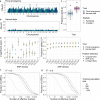The apple REFPOP-a reference population for genomics-assisted breeding in apple
- PMID: 33328447
- PMCID: PMC7603508
- DOI: 10.1038/s41438-020-00408-8
The apple REFPOP-a reference population for genomics-assisted breeding in apple
Abstract
Breeding of apple is a long-term and costly process due to the time and space requirements for screening selection candidates. Genomics-assisted breeding utilizes genomic and phenotypic information to increase the selection efficiency in breeding programs, and measurements of phenotypes in different environments can facilitate the application of the approach under various climatic conditions. Here we present an apple reference population: the apple REFPOP, a large collection formed of 534 genotypes planted in six European countries, as a unique tool to accelerate apple breeding. The population consisted of 269 accessions and 265 progeny from 27 parental combinations, representing the diversity in cultivated apple and current European breeding material, respectively. A high-density genome-wide dataset of 303,239 SNPs was produced as a combined output of two SNP arrays of different densities using marker imputation with an imputation accuracy of 0.95. Based on the genotypic data, linkage disequilibrium was low and population structure was weak. Two well-studied phenological traits of horticultural importance were measured. We found marker-trait associations in several previously identified genomic regions and maximum predictive abilities of 0.57 and 0.75 for floral emergence and harvest date, respectively. With decreasing SNP density, the detection of significant marker-trait associations varied depending on trait architecture. Regardless of the trait, 10,000 SNPs sufficed to maximize genomic prediction ability. We confirm the suitability of the apple REFPOP design for genomics-assisted breeding, especially for breeding programs using related germplasm, and emphasize the advantages of a coordinated and multinational effort for customizing apple breeding methods in the genomics era.
Conflict of interest statement
The authors declare that they have no conflict of interest.
Figures





References
-
- Food and Agriculture Organization of the United Nations. FAOSTAT (FAO, 2017). Access 19 Mar 2019. http://www.fao.org/faostat/en/#home.
-
- Kumar, S., Volz, R. K., Chagné, D. & Gardiner, S. in Genomics of Plant Genetic Resources: Vol. 2. Crop Productivity, Food Security and Nutritional Quality (eds Tuberosa, R., Graner, A. & Frison, E.) 387–416 (Springer Netherlands, Dordrecht, 2014).

